by Ian Skellern
While I’ve watched over the last decade as Pascal Raffy has deftly transformed modern Bovet into a serious mid-sized brand with a comprehensive collection of largely in-house developed and manufactured timepieces, some with quite sophisticated complications, few of the brand’s models have caught my attention.
And that hasn’t been from a lack of eye-catching art and innovation on Bovet’s behalf; it’s just that the ornate and intricate artwork that the brand is so well known for comes across as a bit too busy for me. My personal taste tends towards simplicity in aesthetics, while aficionados of Bovet (and there are many) seem to appreciate more elaborate design. To each his own.
But then along came the Bovet Ottantasei by Pininfarina, which for me a near perfect watch.
Engineered for comfort
For me, watches are to wear and enjoy so I place a premium on comfort and being able to see (and appreciate) as much of the movement as possible.
Display backs, open dials, and skeletonized watches all pander to my desire to be able to observe the inner workings of wristwatches, but my nec plus ultra are those timepieces that have been developed from the ground up to showcase the movement.
My Holy Grail of such rare timepieces is the Greubel Forsey Double Tourbillon 30° Technique (see The Greubel Forsey Double Tourbillon 30° Technique: What’s Friction Got To Do, Got To Do With It!?). But the Technique has one major drawback for me: its 48 mm case diameter makes it too large for comfort on my small wrist.
What are the chances of another watch coming along that has been developed to display as much of the movement as possible, featuring interesting horological innovations, and is comfortable to wear on a smaller wrist?
Pretty high, actually.

Bovet Ottantasei by Pininfarina on the wrist
Bovet and Pininfarina
While Italian design house Pininfarina (see Pininfarina: The Mecca Of Supercar Design And The Bovet Ottantasei) is perhaps better known for designing many, if not most, of the most sensually streamlined supercars on the planet, the company also designs everything from motor yachts to skyscrapers. And as it turns out, watches as well.
The partnership between Pininfarina and Bovet began in 2008. To date this has resulted in the following models: Ottanta Tourbillon (2010), Cambiano Chronograph (2011), the second-generation tourbillon Ottantadue (2012), the third-generation tourbillon Ottantatre (2013), Sergio Split-Second Chronograph (2014), and the Ottantasei Tourbillon (2016).
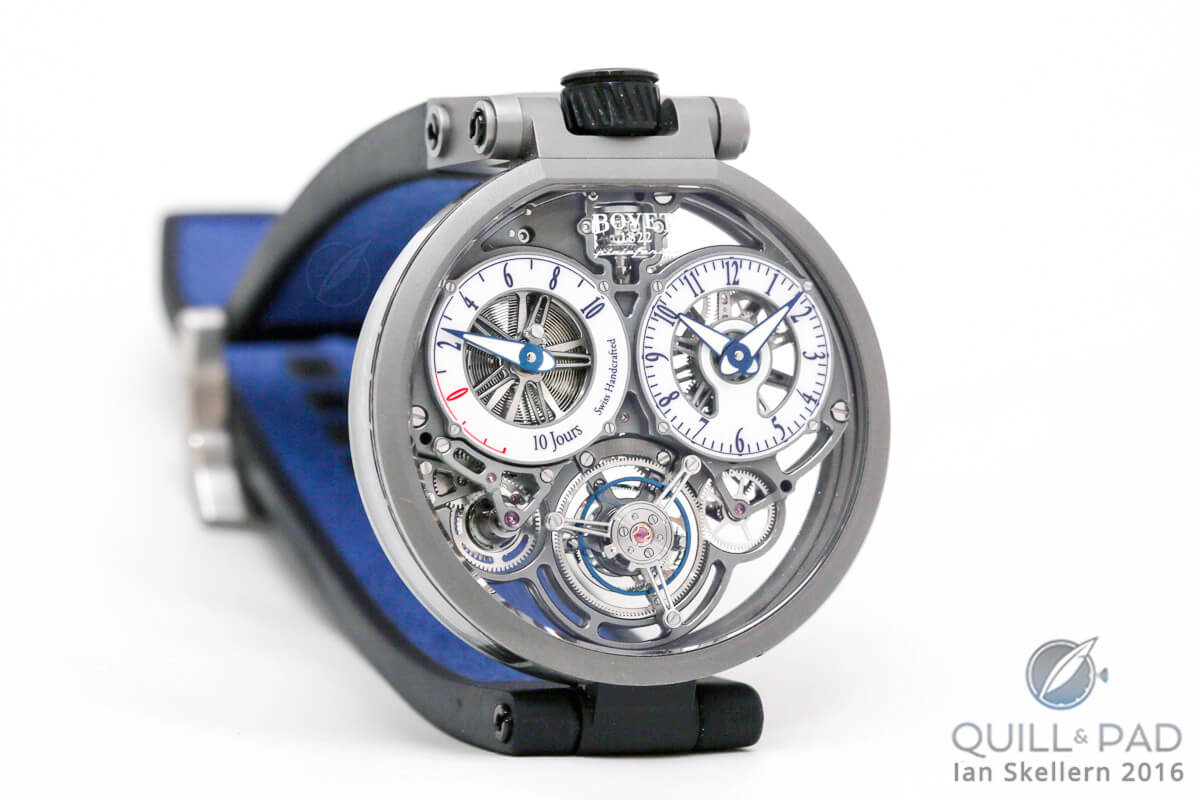
Bovet Ottantasei by Pininfarina
Bovet Ottantasei by Pininfarina
The brief from Bovet to Pininfarina for the Ottantasei was, indeed, brief:
- Maximum transparency/minimum weight (think aerospace)
- Slim and ergonomic
- Ottanta visual identity
- Flying tourbillon
It’s impossible for me to exaggerate just how far both Pininfarina and Bovet pushed the limits in each of those categories.

Bovet Ottantasei by Pininfarina in DLC-coated titanium
But, I can’t help but feel that when developing the Ottantasei, Pininfarina and Bovet reduced the watch and movement to nearly absolute perfection . . . and then took off a tiny bit more. A tiny bit too much. And that vexes me all the more because this watch is otherwise flawless in what it sets out to do.
And when I say they “took off a tiny bit more,” I mean “tiny bit” as measured in atoms, not grams. But that’s enough.
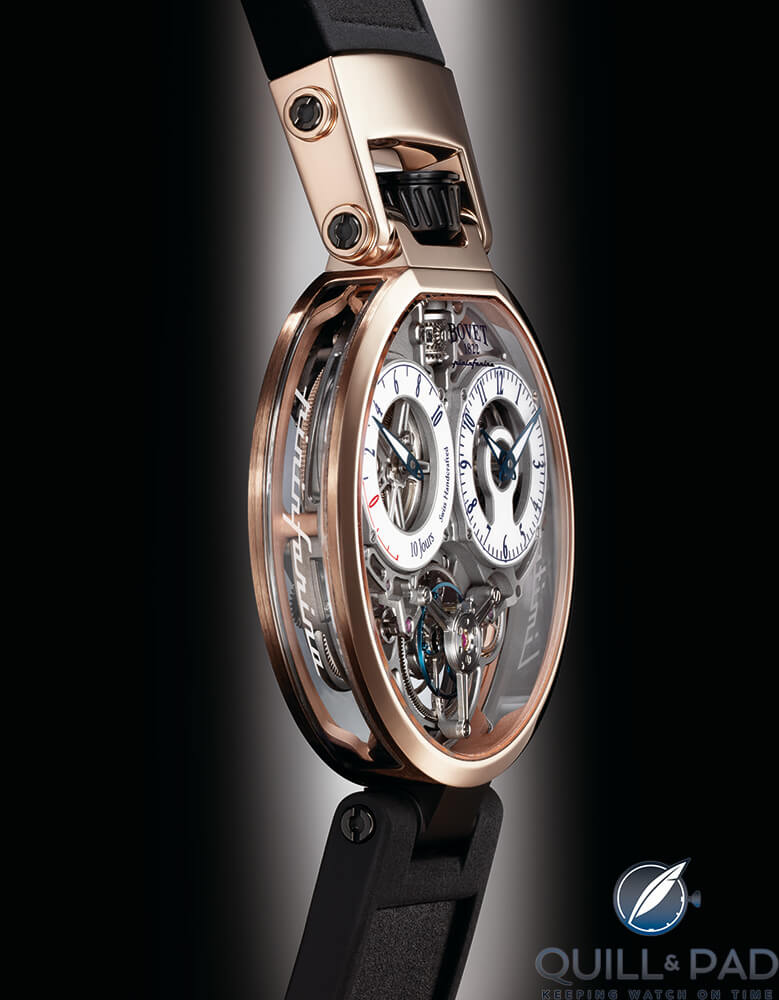
Bovet Ottantasei by Pininfarina in red gold
To put the development of the Ottantasei into some context, on one hand we have Pininfarina, a world-class, if not world-leading, design company with an enviable curriculum vitae. Then we have Bovet 1822, a brand I’d describe as being guided strongly by “tradition,” but quite untraditionally with its own full manufacture in Dimier 1738 – and it is one of very few brands to even have its own hairspring manufacture.
If Pininfarina can imagine something, then chances are that Bovet can make it.
Maximum transparency/minimum weight
In Pininfarina’s world, the word “cars” actually means “supercars,” so it should come as no surprise that the designers likened “maximum transparency/minimum weight” (think aerospace) to the adrenaline-filled worlds of supercars, supersonic jets, and helicopters.

Pininfarina’s inspiration for “lightness” in the Bovet Ottantasei
More glass is better; it’s all about the view. Though in the case of the Ottantasei, this means the view is from the outside in rather than from the inside out.
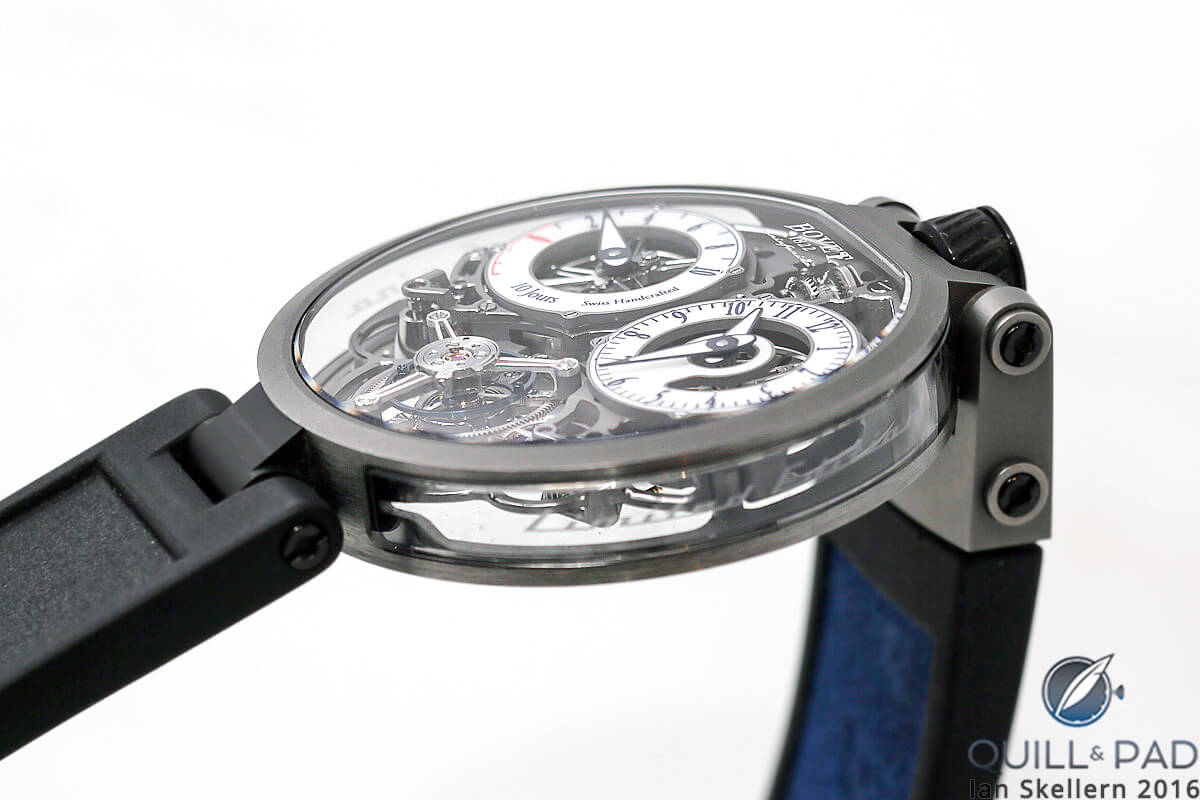
Bovet Ottantasei by Pininfarina
Ottantasei has no less than four sapphire crystals: the upper and lower (display back) having quite complex forms to ensure maximum strength for minimum thickness, while the two side windows are so long that the effect is of a sapphire case with a thin metal frame.
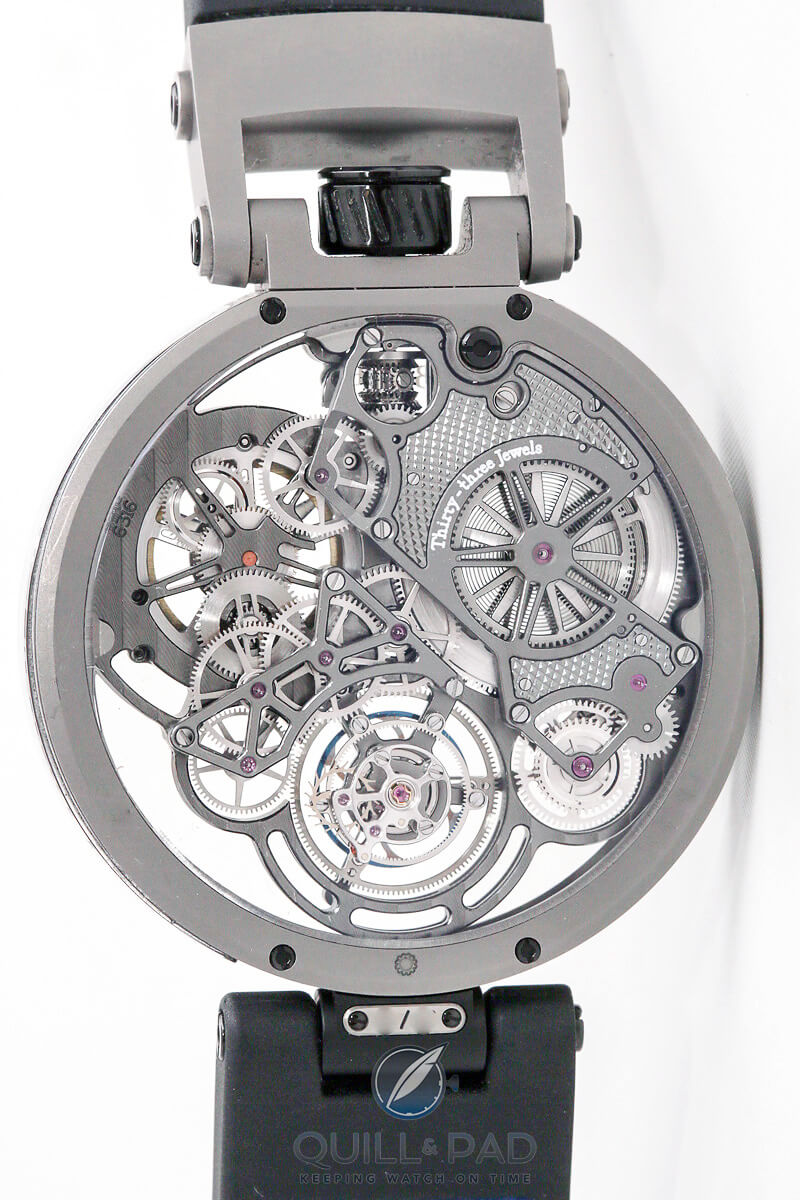
View from the back of the Bovet Ottantasei by Pininfarina
That back crystal does more than offer a tantalizing look into the reverse side of the movement: it supports the movement. In a clever method of reducing height to an absolute minimum, the movement is fixed to the back crystal; both are fitted into the case as one.
The 44 mm diameter case weighs just 51.66 grams (< two ounces) in red gold and a feather-light 15.54 grams (0.54 ounces) in grade 5 titanium. And at just 12 millimeters thick, the Ottantasei is very comfortable on the wrist, even a slim wrist. The familiar design elements of the bow, the 12 o’clock placement of the crown, the visible screw heads, the typical bezel, and the single lower lug at 6 o’clock all ensure that the Ottantasei is firmly – and visibly – rooted in the Ottanta collection.
The movement
Bovet Caliber 17BM03 features the most complex main plates ever created by the manufacture, one in perfect balance between being as light a possible while being strong enough to contain and control the long ten days of power stored in the mainspring.
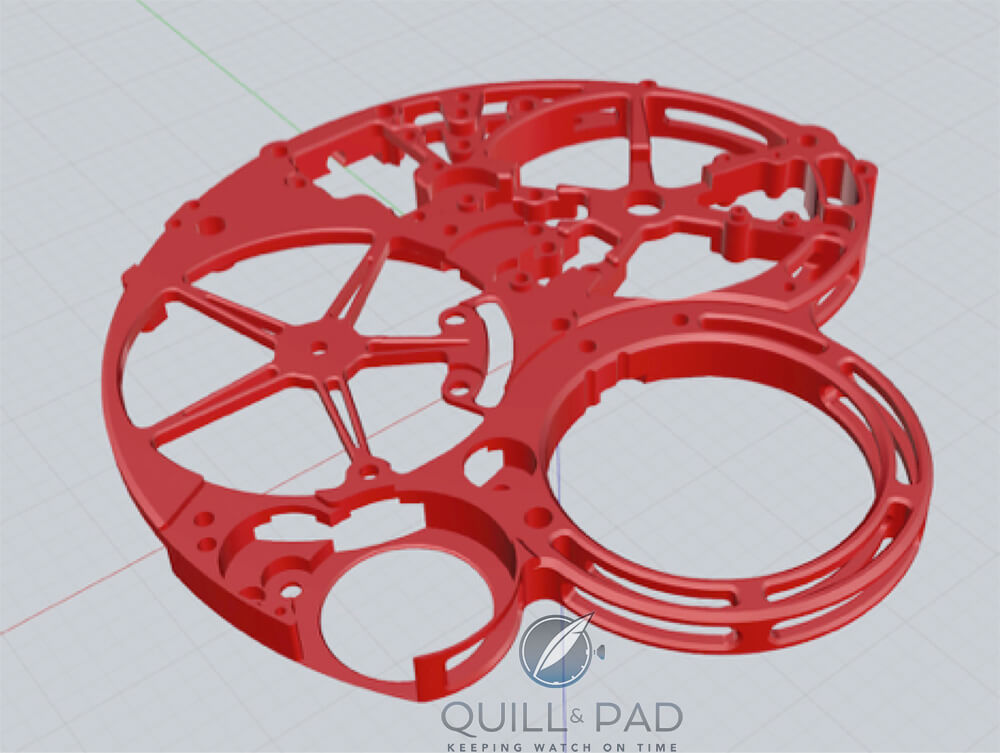
Computer image of the complex main plate of the Bovet Ottantasei
The movement has been awarded three patents: two related to the winding system and one to the flying tourbillon.

Bovet Ottantasei by Pininfarina
Patented flying tourbillon
The main advantage to a flying tourbillon is that its construction does not require an upper supporting bridge so it is easier to see and appreciate the highly animated mechanism. But supporting a structure at only one end usually means added tension, as it isn’t naturally balanced.
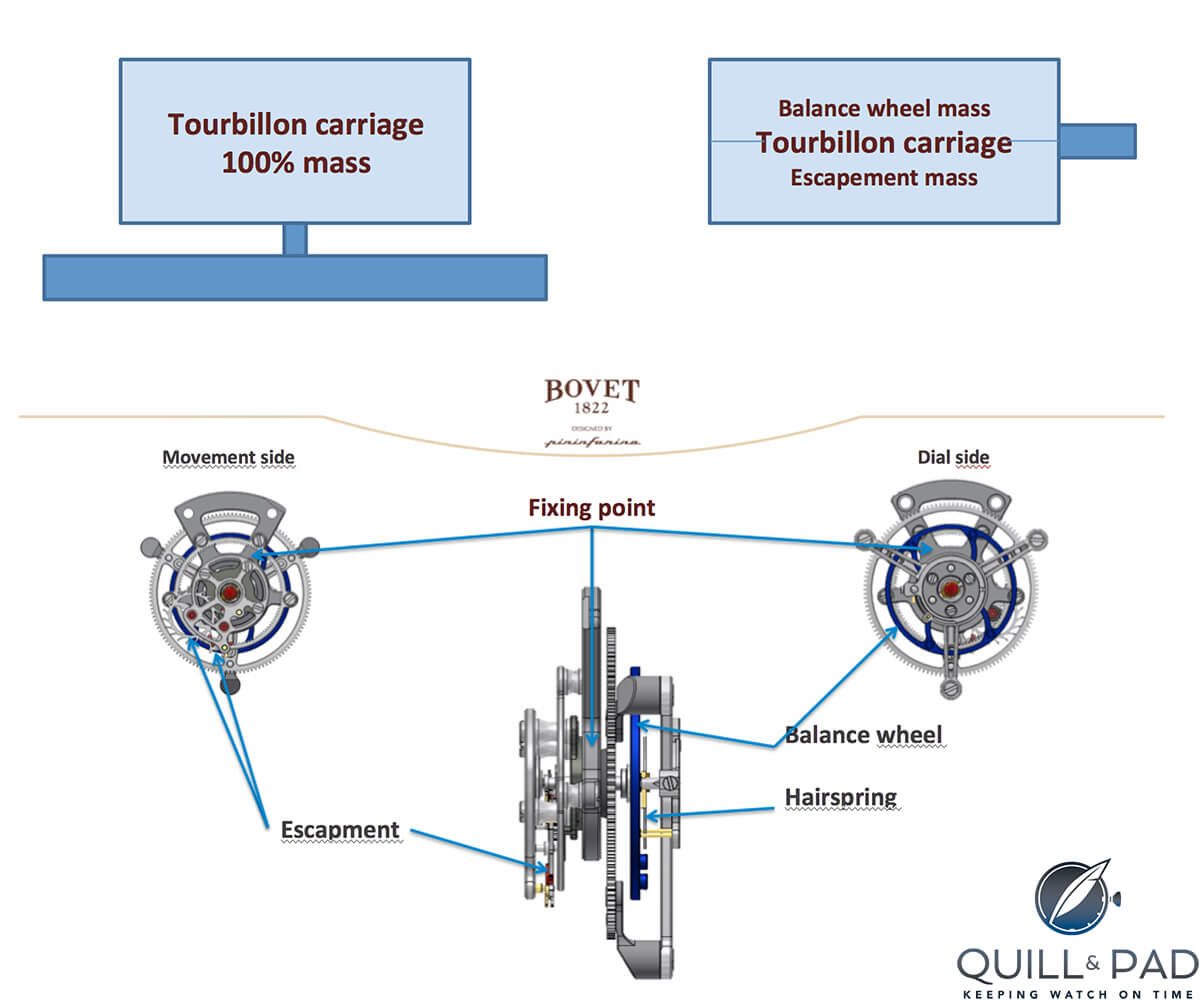
Patented flying tourbillon on the Bovet Ottantasei by Pininfarina (diagram courtesy Bovet)
What Bovet has done is to support the flying tourbillon from near its center instead of its base, which allows for the mass of the lower balance and upper tourbillon cage to balance each other out.

Closer look at the patented flying tourbillon of the Bovet Ottantasei by Pininfarina
This system also allows better views and appreciation of the components comprising the regulator, with the tourbillon cage on full view from the top and the balance from the back.
Power reserve indicator
The three-dimensional power reserve indicator is also quite interesting. As the spring barrel slowly unwinds, it turns a wheel that rotates a polished steel cone around a central threaded screw, moving the cone up and down the screw.
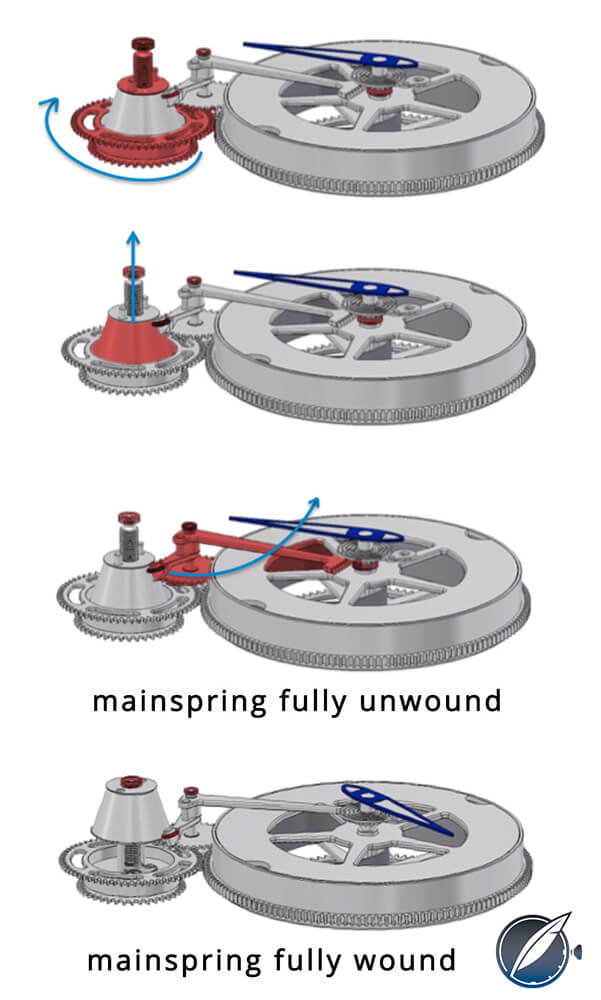
Cone-based system for the power reserve indicator on the Bovet Ottantasei by Pininfarina (diagram courtesy Bovet)
A small lever tracks the vertical position of the cone, transmitting the information to a long lever with a rack that rotates the power reserve indicator. The system is simple, reliable, and interesting to watch, especially when the movement is in the process of being wound.
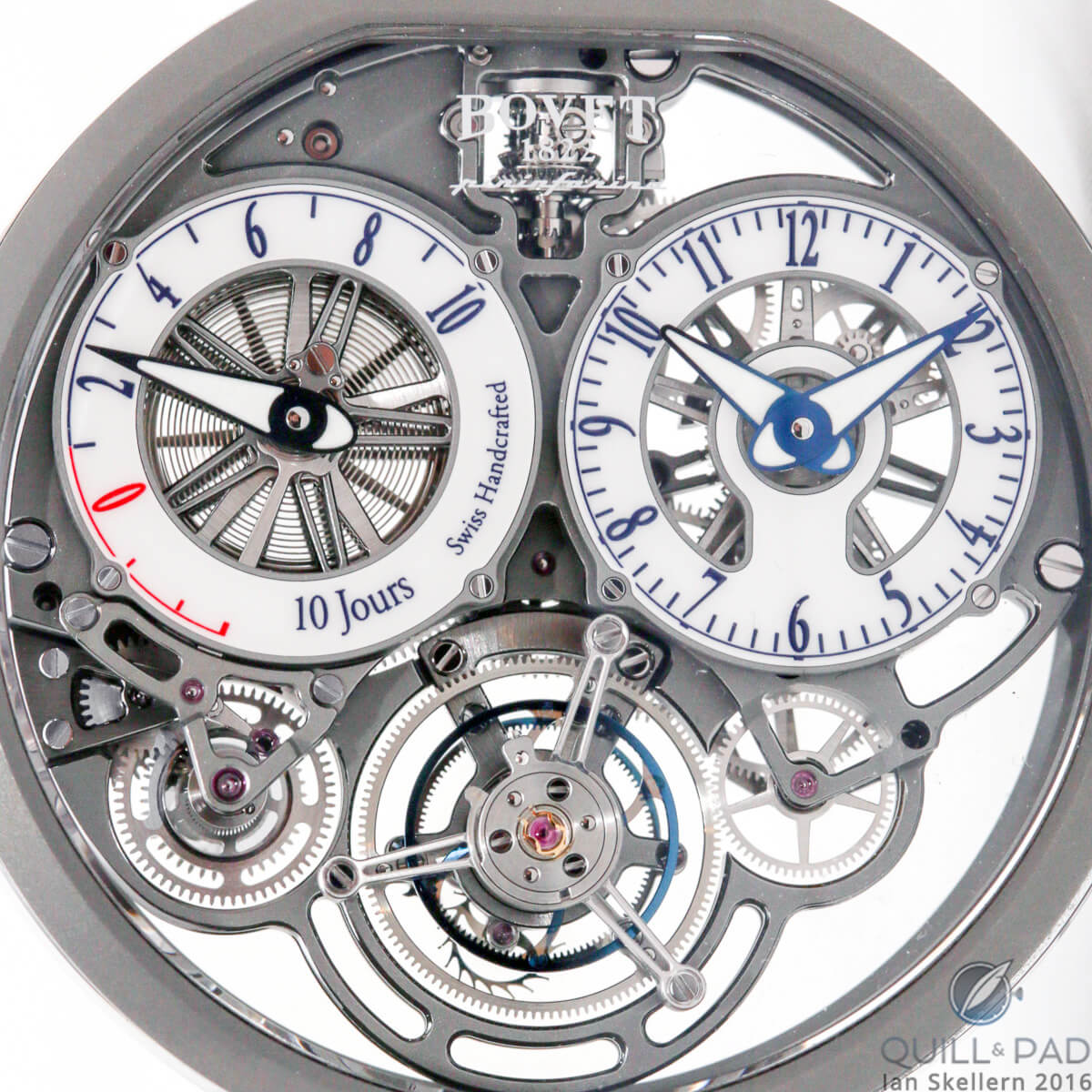
Dial side of the Bovet Ottantasei by Pininfarina
Three-dimensional winding system
While a fully wound watch with a ten-day fill of power is a wonderful thing, it takes quite a lot of winding to fill the empty “tank.” So Bovet’s engineers developed a patented winding system with a spherical differential and reduction gearing allowing the mainspring to be wound twice as fast for the same number of turns. The system also reduces the number of components required, reducing friction and increasing reliability.
The profile of the specially developed three-dimensional gear was awarded a patent as it allows for gearing, even multiple gearing, to connect efficiently at a multitude of angles.
Finishing
Not only is the movement sketetonized on all horizontal surfaces to ensure that there is absolutely no excess weight, the vertical surfaces have also been sketetonized. And as virtually all of the movement is visible from all angles, bridges and plates have anglage on all four faces of the components (two horizontal, two vertical) rather than the more usual two.
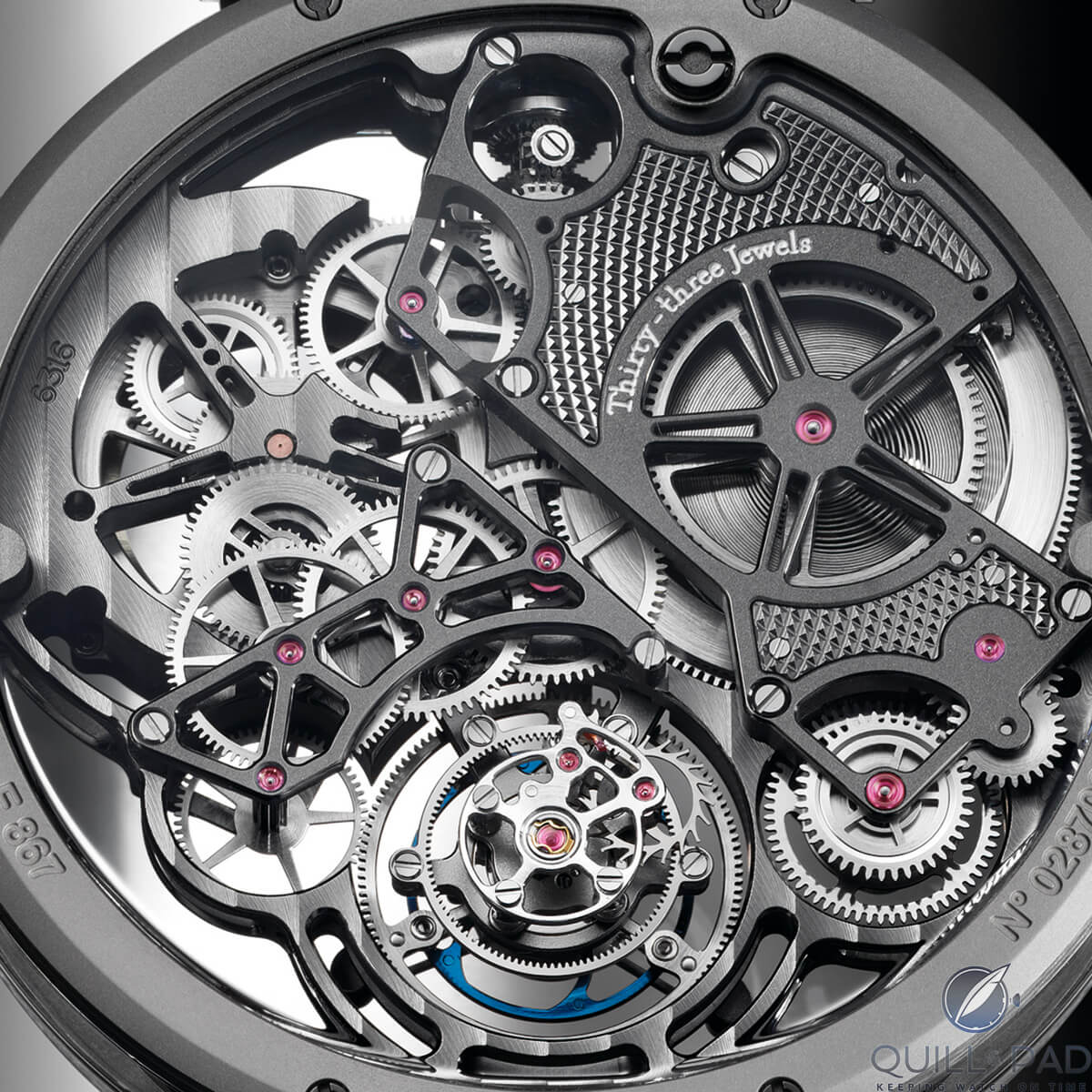
View through the Bovet Ottantasei by Pininfarina’s display back to the clous de Paris decoration on the spring barrel bridge
I particularly like the curved lines in the clous de Paris engraving visible through the display back. Traditional clous de Paris is usually a grid pattern set at right angles; however, not being aware of all the centuries of horological tradition, on seeing the proposed finish Pininfarina’s designers thought it would look better still if the engraving followed the curves of the bridges. And so it came to pass.
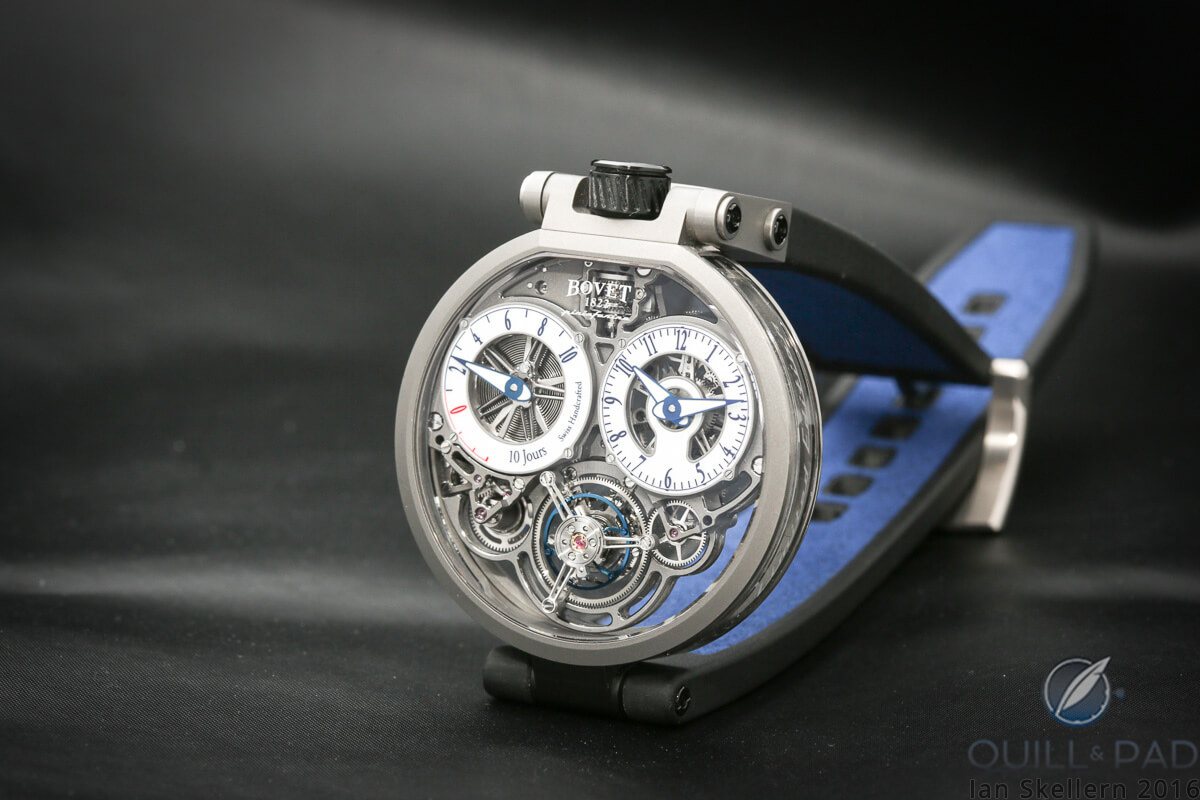
Bovet Ottantasei by Pininfarina
What irks me ever so sightly
I was surprised by just how much I was impressed with the Ottantasei and would be very happy to wear one daily. But there is one niggle I have that I just can’t shake off because (to my thinking) it goes against the whole spirit of transparency: that laser engraving on the side windows.
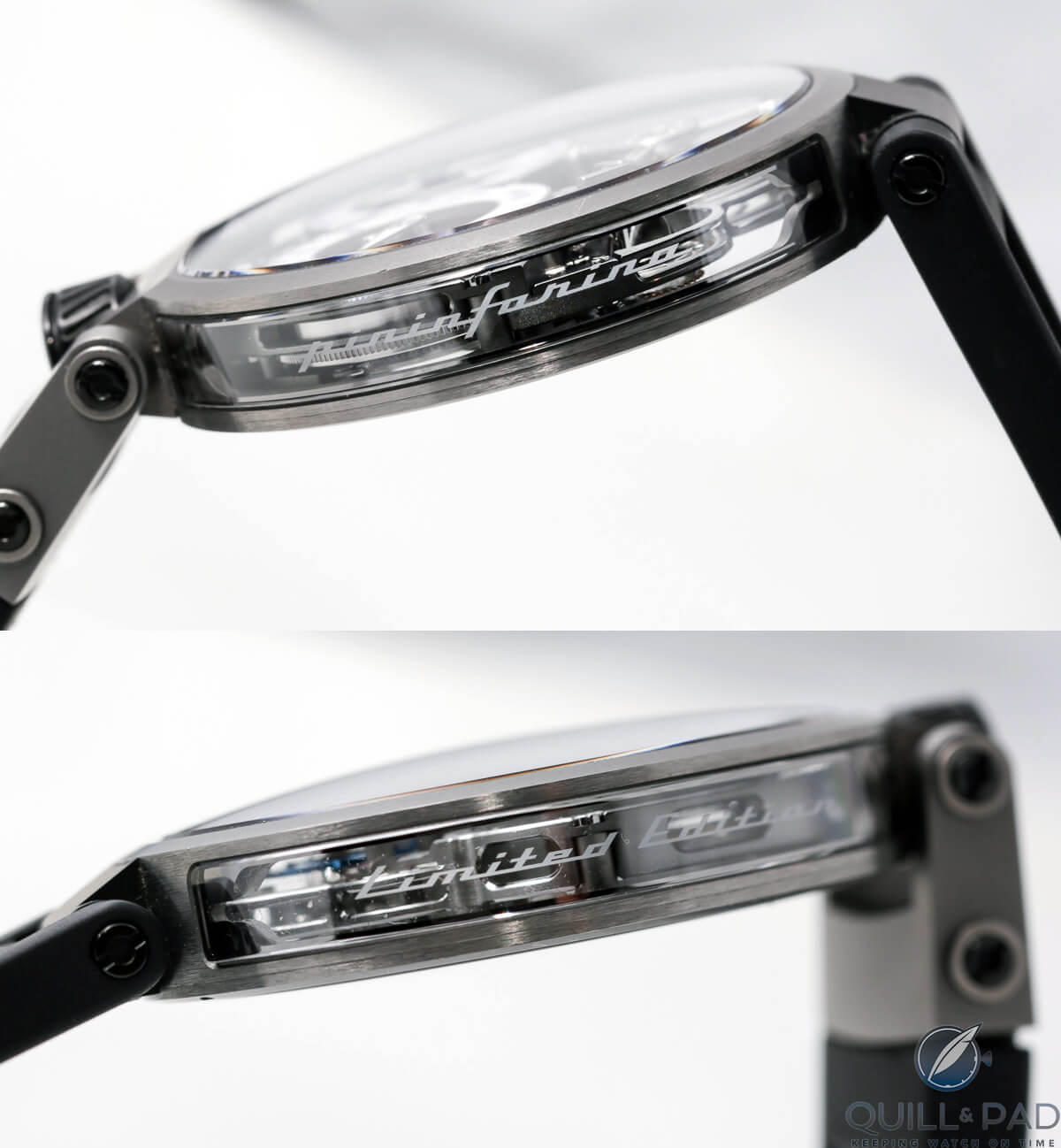
Laser-engraved “Limited Edition” and “Pininfarina” on the case band windows of the Bovet Ottantasei
And again dial side where we have the beautiful spherical differential and a patented winding system covered by the Bovet logo. Why do that when there is blank space either side?
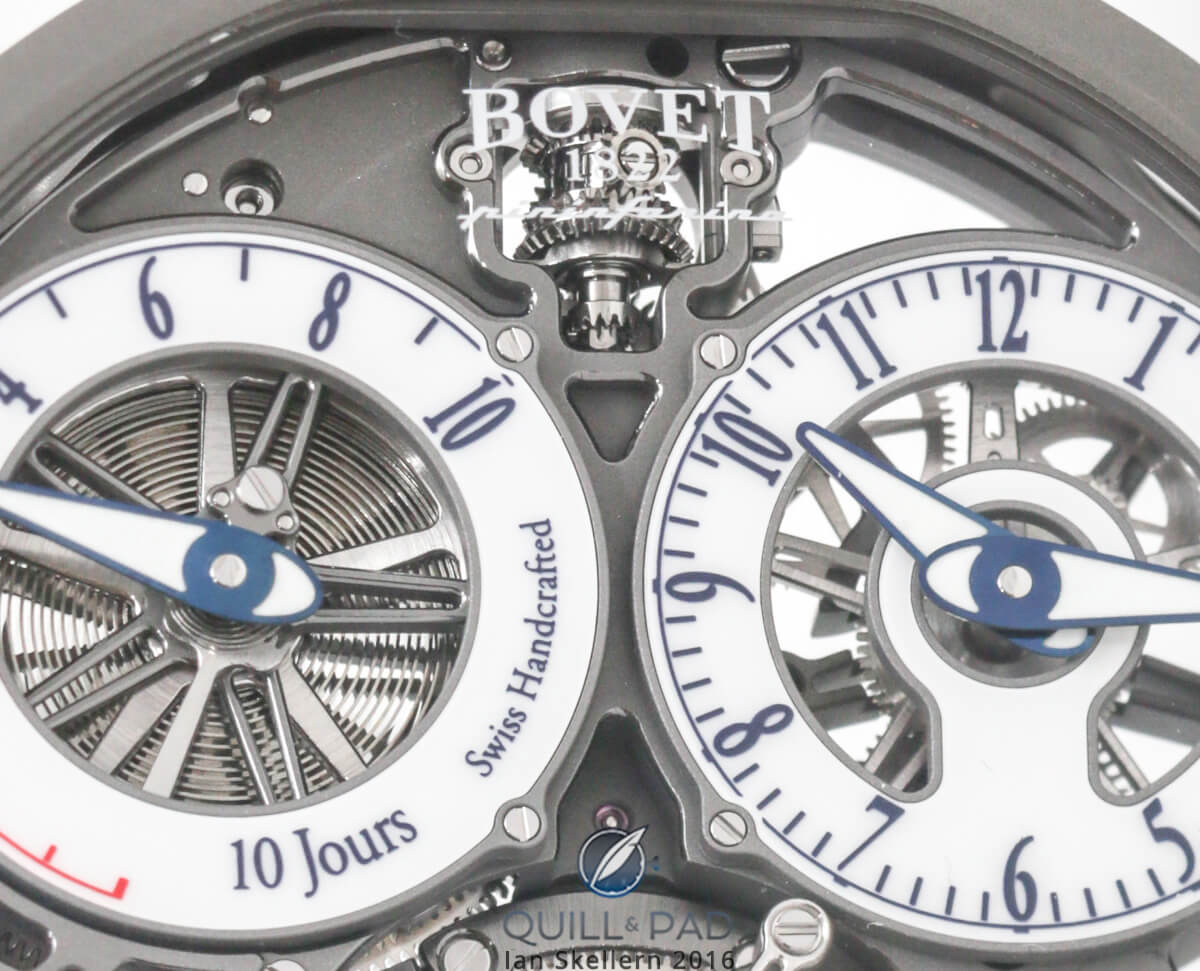
The spherical differential of the Ottantasei is visible behind the Bovet logo at 12 o’clock
Imagine a home with two big bay windows opening onto a fantastic view, but covered with non-transparent (and non-essential) text.
Such a small detail, but it’s the small details that count!
I liked the Ottantasei so much it surprised me. I appreciate the vast majority of the watches I have the pleasure and good fortune to examine mainly from an intellectual point of view in that while I understand and like their various features, I do not think of them as watches I personally would wear because they are either too big, too small, too complicated, wrong color, wrong shape, etc., etc., etc.
But the Bovet Ottantasei by Pininfarina is not only a timepiece that I like from an intellectual point of view, I also like it from the heart: it’s a watch I would be very happy to own and wear.
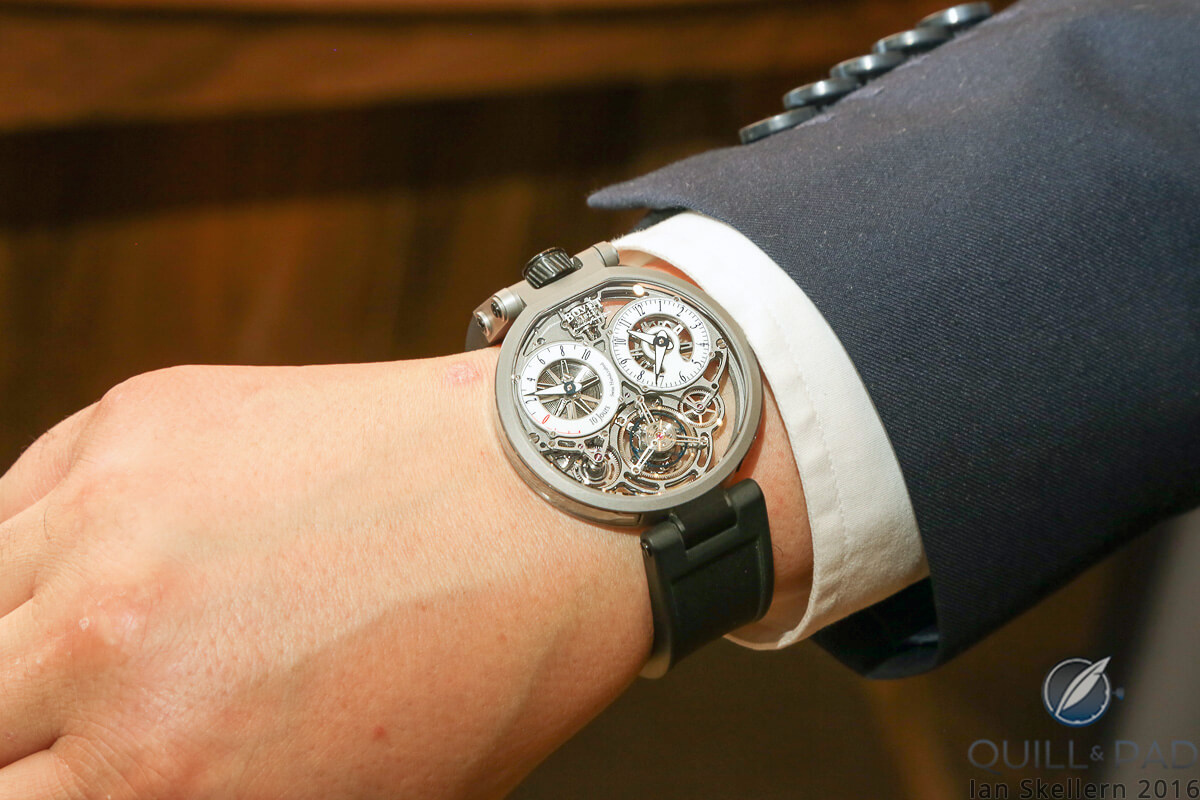
Bovet Ottantasei by Pininfarina on the wrist of Paolo Pininfarina
For more information, please visit www.bovet.com/timepiece/bovet-by-pininfarina-ottantasei.
Quick Facts Bovet Ottantasei
Case: 44 x 12 mm, available in titanium, black DLC-coated titanium and red gold; sapphire crystal display back and two case band windows, water resistance 30 meters
Dials: available in either white lacquer or brushed blue
Movement: manually wound Caliber 17BM03 with 10-day power reserve; patented spherical differential winding system, 2.5 Hz balance, patented flying one-minute tourbillon
Functions: hours, minutes; power reserve indicator
Limitation: 86 pieces (total)
Guarantee: 5 years
Price: 165,000 Swiss francs (excluding taxes) in titanium or DLC-coated titanium; 180,000 Swiss francs (excluding taxes) in red gold
* This article was first published on July 12, 2016 at Transparently Sublime Bovet Ottantasei By Pininfarina: Near Perfection.
You may also enjoy:
Bovet Récital 26 Brainstorm Chapter One: Design Intent Uncompromised
Bovet At SIHH 2019: Golden Hands And Amazing Watches (Video)
The Astronomical Grandeur Of The Bovet Récital 22 Grand Récital
Above And Beyond: Bovet Récital 18 Shooting Star
Leave a Reply
Want to join the discussion?Feel free to contribute!





















































Ian, you have nailed it. Totally agree on the branding ruining some beautiful views. It must be a terrible burden to have to try watches like this. Do you need some help sharing the burden?